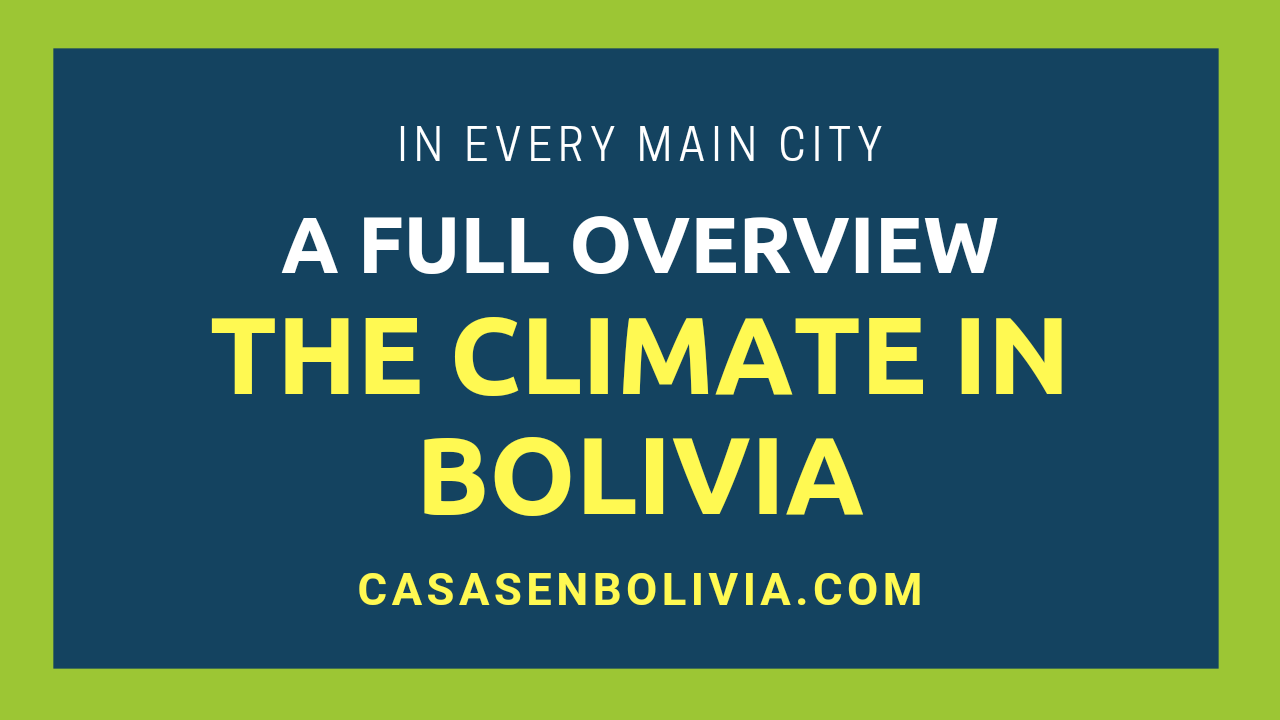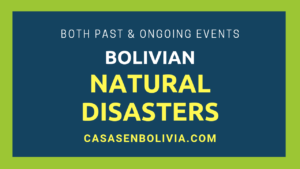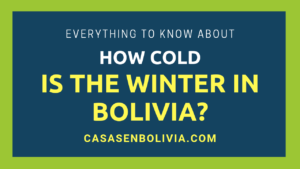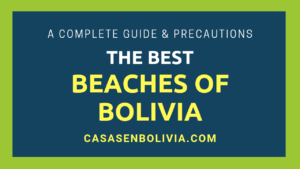Last Updated on February 15, 2025
Many foreigners mistakenly believe that Bolivia is solely an Altiplano country. In reality, most of Bolivia’s territory is covered by flat tropical lowlands, very near or even within the Amazon basin. Furthermore, this area contains the majority of Bolivia’s population. There are also significant health risks associated with the country’s various climates that you need to be aware of before visiting or residing in Bolivia.
Bolivia has three distinct climates: 1) a cold, alpine, and dry climate in the western region, with an average temperature of 55°F; 2) a temperate, balanced, and moist climate in the central area, with an average temperature of 70°F; and 3) an Amazonian, tropical, and very humid climate in the eastern region, with an average temperature of 85°F.
We are Bolivian citizens who have spent our entire lives here. We’ll provide you with comprehensive details about the different climates experienced throughout our country and its population. We’ll also highlight some significant health hazards you may encounter when visiting, which are closely linked to Bolivia’s climates, and offer precautions to mitigate these threats.
Bolivia’s Three Main Climates
Contrary to popular belief among many foreigners, Bolivia is not solely a cold, high-altitude Altiplano country. In fact, approximately 40% of the population lives in tropical and Amazonian regions. Moreover, Bolivia’s largest city, Santa Cruz de la Sierra, is situated on very tropical and warm land.
Bolivia’s territory encompasses three distinct climate zones:
- The cold and arid Altiplano of western Bolivia.
- The rugged and hilly temperate central region of Bolivia.
- The hot and humid tropical eastern region of Bolivia.
| Altiplanic West | Temperate Center | Tropical East | |
| Main Cities | La Paz, El Alto, Oruro, Potosí | Cochabamba, Sucre, Tarija | Santa Cruz, Trinidad, Cobija |
| Population | 4,200,000 | 3,000,000 | 4,800,000 |
| Main Features | Cold year-round; La Paz is warmer; mostly dry but also moist. Snow and hail are common. | Mild and temperate weather; moderate humidity; rarely freezing. | Amazonian climate; somewhat colder in Santa Cruz; very humid year-round. |
| Avg. Temperature | 60°F (day), 40°F (night) | 75°F (day), 55°F (night) | 85°F (day), 70°F (night) |
| Geography | High elevation (~13,000 ft above sea level); vast, flat terrain; the “Altiplano.” | Moderate elevation (8,000 ft above sea level); rugged and mountainous land with numerous valleys. | Low elevation (1,500 ft above sea level); flat, endless tropical terrain, partly within the Amazon; also marshy ground. |
| Flora and Fauna | Limited flora and fauna; no insects or dangerous animals present. | Vinchuca bug widespread; other somewhat risky animals present; beautiful gardens throughout. | Dense jungle; Vinchuca also present; mosquitoes widespread; numerous other wild animals. |
| Climate Threats | Sunburn (frequent), hypothermia (uncommon) | None | Heatstroke (rare), tropical storms (common), Surazos (mid-year), floods (occasional), marshy ground (occasional) |
| Health Dangers | Altitude sickness (common) | Chagas disease (very common; half the population carries the parasite) | Chagas disease (common; a quarter of the population carries the parasite), Malaria, Dengue, Zika, and other diseases (quite frequent) |
1) The Cold and Arid Altiplano of Western Bolivia
This vast and flat region of Bolivia is located in the western part of the country and encompasses approximately 35% of its total territory. Its average elevation is around 13,000 ft (4,000 m) above sea level, and its average temperature ranges from 50°F to 68°F during the day and 23°F to 50°F at night. The cities of La Paz, El Alto, Oruro, and Potosí are situated in this region.
You might think this altitude is too high for habitation, *but in reality, about 3.5 million people reside in this area*, distributed across four principal cities and rural areas. However, if you visit this region and its cities without proper acclimatization, you’ll likely experience the effects of reduced oxygen levels.
“Altitude Sickness“ is a common ailment experienced by many tourists and individuals from lower altitudes when arriving in this zone and its cities. Although very rare, there have been approximately 20 reported cases of brain swelling in the past 50 years among people who suddenly traveled to this region. Always be mindful of this possibility and take all necessary precautions.
In essence, this part of Bolivia resembles a desert, with a very flat landscape extending towards the horizon, mountain ranges far in the distance on both the eastern and western sides, and predominantly dry and cold air. However, unlike typical deserts, this region receives considerable rainfall. Usually, this region is very sunny, but some days are cloudy and rainy.
People typically wear thick clothing with multiple layers. However, the weather is not always like this. In spring and part of summer (between October and January), temperatures typically rise to an average of 77°F during the day and 50°F at night.
Conversely, particularly in winter (from May to July), you’ll experience quite cold temperatures, with daytime temperatures below 60°F and freezing temperatures at night. Some days will also feature snow and hail. Finally, between January and March, there will be rain and sometimes heavy hail in this part of the country.
The following four principal cities are located in this region of Bolivia:
- La Paz (800,000 population, 11,975 ft / 3,650 m elevation)
- El Alto (700,000 population, 13,123 ft / 4,000 m elevation)
- Oruro (400,000 population, 12,254 ft / 3,735 m elevation)
- Potosí (200,000 population, 13,353 ft / 4,070 m elevation)
2) The Rugged and Hilly Temperate Center of Bolivia
This mountainous region of Bolivia is almost entirely covered with valleys and is located in the center of the country, *serving as a transition zone between the cold Altiplano to the west and the warm, tropical lowlands to the east*. It occupies approximately 25% of the total territory and boasts the most comfortable temperatures for living, ranging from 59°F to 77°F most of the time. Its average elevation is around 8,202 ft (2,500 m).
Bolivians often visit this region and its cities *for vacations, due to its very pleasant climate*. During the day, the temperature is very comfortable, and it doesn’t get excessively cold at night. It’s also not too dry nor too rainy. The air is somewhat humid but not overwhelming, and the weather is very stable throughout the year.
However, this region has a hidden risk *that you must not overlook under any circumstances*: “Chagas Disease,” transmitted by the “Vinchuca” insect, which is endemic to this area.
Caution: Health Risk!
You must be extremely cautious *in these three cities* because of the risk of “Chagas disease,” a serious illness that damages your heart, can be fatal, and often has no cure. It’s endemic in these cities (in Cochabamba, 35% of the population carries the parasite, up to 54% in Sucre, and 48% in Tarija). You should always seek living spaces *that are fully plastered, without any cracks, and take other precautions*. Be extremely vigilant!
After addressing this very dangerous health situation, you’ll enjoy one of the best climates in Bolivia. The pleasant weather in this zone is the primary reason why many people call Sucre the “garden city” and why many Bolivian retirees relocate to Cochabamba for their later years.
Cities within this region of Bolivia are almost entirely covered with green spaces, *but not jungles – just forests and grasslands*. Beyond the “Vinchuca” bug, you won’t encounter many other dangerous or bothersome insects. In other words, cities in this area of Bolivia are like vast gardens.
Three principal cities are located in this part of Bolivia:
- Cochabamba (650,000 population, 8,392 ft / 2,558 m elevation)
- Sucre (400,000 population, 9,919 ft / 2,810 m elevation)
- Tarija (350,000 population, 6,083 ft / 1,854 m elevation)
It’s worth noting that for a few months each year, between September and November, the southern rural area of the Tarija department (*not the city of Tarija*) is typically very dry and hot. Temperatures can reach up to 105°F without any rain, *creating desert-like conditions*. This zone is called the “Gran Chaco” desert.
3) The Hot and Humid Tropical Eastern Region of Bolivia
This is Bolivia’s largest area, with a unique climate among the three we’re presenting. It occupies around 40% of Bolivian territory *and is primarily flat, Amazonian, tropical lowland*. The air is usually very humid, and the temperature averages 85°F during the day and 70°F at night. Its average elevation is around 1,640 ft (500 m).
The majority of Bolivia’s population resides in this area, with most concentrated in Santa Cruz de la Sierra, the largest city in Bolivia, with a population of 1.5 million. *People in this region of Bolivia exhibit behaviors similar to those of Caribbean populations*, as they experience a quite hot, humid climate. It’s truly a tropical place, and all the cities within this area are hot and humid year-round.
The land in this area is almost entirely covered with dense jungle, and insects and bugs are, in many cases, overwhelming. This is particularly true on the outskirts of cities, as you won’t find as much jungle or as many insects in downtown areas.
Usually, primarily during the summer and part of the spring (from November to February), this zone of Bolivia becomes even warmer, like a true Amazonian region, with temperatures reaching 95°F during the day and 80°F at night, accompanied by high humidity, significant rainfall, and occasional tropical storms. However, in the other months, it will be drier and cooler, making it more pleasant to live in.
Although unlikely, sometimes, primarily from November to January, there’s also a risk of heatstroke in cities like Santa Cruz, Trinidad, or Cobija, with temperatures reaching 105°F on some days, combined with very humid air.
Caution: Risk of Endemic Diseases!
Bolivia’s tropical eastern region is also endemic for Chagas disease (a deadly illness that damages your heart and has no cure, transmitted by the Vinchuca and similar insects). In fact, 22% of the population of Santa Cruz has this illness. *There’s also a high risk of contracting Malaria, Dengue, and Zika in this region, even within its cities.*
You should always use a mosquito net over your bed when sleeping, *without exception, even if you’re inside your house* (as 99% of people in this region do). Take all other necessary precautions, which go beyond this article, to prevent these illnesses from affecting you when staying or living in this part of the country.
You need to be very cautious here about insects and other reptiles, such as mosquitoes, snakes, and spiders, primarily present on the outskirts of cities and in rural areas, but also quite often in downtown areas.
This is why all residents in this area (*without exception, even in urban and affluent neighborhoods*) use mosquito nets for their beds. When staying in this part of Bolivia:
- Always use a mosquito net when sleeping.
- Always ensure that this net and your bed are free of insects and other creatures before entering your bed.
- Securely seal the net to the bed after getting into bed.
- Also, never leave it uncleaned or open after you wake up,
- And make no exceptions to these rules.
Numerous insects and animals are present in this area of the country *because it’s essentially a vast, flat tropical jungle*, an Amazonian region (in fact, it’s part of the Amazon), with abundant rainfall, wide rivers, and a huge, complex ecosystem. Urban areas have removed most of the jungle from within their boundaries, *but it quickly reappears* in almost any area that is not properly maintained.
Three principal cities are located in this part of Bolivia:
- Santa Cruz de la Sierra (1,500,000 population, 1,312 ft / 400 m elevation)
- Trinidad (150,000 population, 427 ft / 130 m elevation)
- Cobija (60,000 population, 919 ft / 280 m elevation)
The Climate by Major City in Bolivia
Santa Cruz
Santa Cruz de la Sierra is Bolivia’s largest city, with a subtropical and, most of the time, tropical climate throughout the year. In this city, you’ll see the land around you completely flat towards the horizon, mostly covered with grass, shrubs, and trees in the downtown area, and almost jungle-like terrain on the outskirts.
This city experiences significant rainfall at the beginning and end of the year, but less rainfall in the middle of the year. Typically, you have hot temperatures, averaging 90°F during the day and 75°F at night. Sometimes, it rains so heavily that many neighborhoods become flooded, with the poorest neighborhoods being the most affected.
However, in general, the days are very sunny and humid, so people tend to wear only T-shirts and shorts all the time. You’ll start sweating very quickly until you acclimate to the weather. People there behave in many ways like Brazilians or Caribbeans, as Santa Cruz’s climate is very similar to those regions.
The air is mostly humid, but sometimes you’ll experience what are called “Surazos,” which are strong, freezing, and dry air currents *that originate from the South Pole*. When this occurs, which can last for days or weeks, people typically wear very thick clothing, as if they were in a cold alpine climate. But this only happens a few times a year, *during the winter, from May to July*.
Remember to take all necessary precautions to avoid endemic diseases like Chagas in this city, as we mentioned in a previous section.
La Paz
La Paz is a mostly cold city at a very high elevation. This city is slightly warmer than Oruro and Potosí and doesn’t experience extreme freezing air currents because it’s situated within a canyon in the Altiplano terrain. Typically, the temperature during the day averages 65°F and 50°F at night. The air feels mostly dry but not excessively so, with some very humid days as well.
The city doesn’t receive much rainfall in autumn and winter, but it rains heavily in summer and significantly in spring (from November to March). Also, temperatures can drop to freezing levels at night during parts of autumn and winter (from May to August), with heavy snowfall and hail on some days of these seasons.
In general, people in this city tend to wear a lot of winter clothing. Moreover, they are not accustomed to wearing dresses, T-shirts, and shorts, and they usually wear pants, jeans, and jackets. However, this changes between October and December, during part of the summer, when temperatures can rise to 80°F during the day and 60°F at night. During this time, some people start behaving as if they were in a warmer climate.
Also in this city, most days are very sunny in winter and autumn. Even though they are very sunny, it’s not enough to warm people up. As you might expect, sunlight can be dangerous at these altitudes. Don’t forget to use sunscreen with at least a 50 SPF factor in this city if you’ll be exposed to the sun for extended periods. In contrast, during the summer, the weather is intermittent, with either very sunny and warm days or quite cloudy days with heavy rain.
Cochabamba
Cochabamba’s climate is very mild and temperate, *neither too hot nor too cold, just well-balanced*, providing warm nights and pleasant days for most of the year. However, this changes in winter, when temperatures can drop significantly, though rarely crossing the freezing point at night. The air in the city is very temperate and calm most of the time, and not excessively humid.
Along with Sucre, this city is called the “garden city” because the vegetation is not overly dense, consisting primarily of light grass, shrubs everywhere, and numerous trees of different species. It’s as if the flora and fauna here have the ideal climate to thrive without becoming overwhelming.
We can say that the climate and weather in this city are truly enjoyable, very calm without excessive heat or cold, both during the day and at night, without too much rain and without being dry at all. The air is also humid, enough to feel very pleasant. This climate is why many older Bolivians and retirees choose to live in this city during their later years.
Insects and bugs are widespread within the city but are not bothersome most of the time. However, you need to be very cautious about the Vinchuca bug, which can transmit “Chagas Disease” and is endemic to this city (see a previous section for more information).
El Alto
This large city (population of 700,000), located adjacent to La Paz, is at a very high elevation. Therefore, as you can imagine, it experiences very cold temperatures almost all the time. These temperatures can average 60°F during the day and 40°F at night. The air is also very dry, and you’re at a high risk of experiencing “altitude sickness” due to the lack of oxygen (see a previous section for more information).
People in this city primarily come from rural Altiplano areas of Bolivia, and they are very accustomed to living in a cold climate throughout the year. In winter, temperatures can drop to freezing levels almost every night, and some days, hail and snow are very common. Moreover, during the year, this city generally has very sunny days, but this sunshine can be more intense. Remember to use appropriate sunscreen with at least a 50 SPF factor.
Currently, few tourists visit this city, and almost no expats or foreigners live there. Instead, most people go to El Alto because of the cable car that connects this city with La Paz. But remember that La Paz’s international airport is located there, so if you travel to La Paz, you’ll be in El Alto for at least a few minutes, or perhaps a few hours.
Sucre
Sucre is a relatively small city that is also called a “garden city.” The weather and temperatures are very comfortable there. It even has a better climate than Cochabamba, with more stable temperatures throughout the seasons, and it’s also slightly warmer.
From a visual perspective, this city is simply beautiful. It’s like a giant garden, with white houses everywhere, and people typically wear light clothing both during the day and at night year-round. The air is somewhat moist but not excessively so. Also, it rains just enough to make you feel comfortable, often with mist and drizzle. The climate is very well-balanced for human beings in this city.
This city is beautiful to live in or visit, and many Bolivians go there on their vacations. However, it’s not common to see many tourists or expats there. When visiting this city, remember to always be cautious about “Chagas Disease,” which is endemic in Sucre (more information in a previous section).
Tarija
Tarija is also a small Bolivian city, located in the south of the country. It sits in a valley at a significant elevation above sea level (6,083 ft / 1,854 m). This is why it generally has pleasant weather year-round. It has almost the same climate as Cochabamba and Sucre, being very well-balanced most of the time.
However, during some months of the year, this city can experience colder temperatures, from May to July, with some nights dropping below freezing. Also, from October to February, it experiences the warmest temperatures of the year, reaching levels of tropical weather, but with significantly less rainfall. Tarija city is also an endemic area for “Chagas Disease” (see a previous section for more information).
It’s worth mentioning that Tarija city is not located within the “Gran Chaco,” which is a very arid, hot, vast, and flat region that resembles a desert. In this area, particularly from August to October, a drought occurs every year, and people living there suffer considerably, sometimes losing livestock and crops.
Oruro
Oruro is an Altiplano city also located at a very high altitude, which is why the city experiences cold temperatures almost year-round. During parts of summer and spring (from October to January), temperatures improve, making it feel similar to Cochabamba or Sucre. These months also tend to have more rain and cloudy days.
However, during parts of autumn and winter (from May to July), Oruro experiences the coldest climate of the year, becoming a cold place with snow and hail on some days and reaching freezing temperatures on some nights. Days during this time of year are generally very sunny, but a few will be somewhat rainy.
When staying in this city, you’ll need to take two precautions: 1) the sun is more intense at these high altitudes, so use a good sunscreen with at least a 50 SPF protection factor, and 2) you may experience “altitude sickness” (see a previous section for more information).
Beyond these concerns, this city can be a pleasant place to be. For instance, during Oruro’s Carnival (at the end of February, marking the beginning of autumn), you’ll experience cold but manageable temperatures (averaging 60°F), with a mix of sunny and cloudy days, and nights that aren’t freezing.
Potosí
Potosí is the smallest Altiplano city in this region of Bolivia, situated at a high elevation. *Its climate is very similar to that of El Alto*, with consistently cold temperatures throughout the year and slightly warmer conditions from November to February. The air in this city is also quite dry, but it receives sufficient rainfall, preventing it from being a desert-like environment.
This city is a classic destination for both domestic and international tourists. It’s also very close to the Uyuni salt flats, but it’s not necessary to go to Potosí first to visit that location.
This vast salt flat is also a cold place with a high elevation of 11,811 ft / 3,600 m. Its temperature is tolerable in spring and summer, but in winter and autumn, it typically experiences freezing temperatures even during the day. The air is dry, and it doesn’t rain during these seasons. However, the Uyuni Salt Flat can become flooded, posing a risk to tourists; be mindful of this.
Trinidad
Trinidad is a very small tropical city in Bolivia, with a climate that’s even hotter and more humid than that of Santa Cruz. Its climate can be described *as distinctly tropical and Amazonian*. In fact, this city is located within the Amazonian region of South America. If you’re in this city, you’ll be surrounded by jungle, with even noticeable fauna in the city’s downtown area.
There are very few tourists and foreigners here, except for individuals from Brazil. During spring and summer, expect significant rainfall and a mix of sunny and cloudy days. *The city also experiences occasional flooding*, as the land is somewhat swampy. Furthermore, during autumn and winter, the climate remains tropical with less precipitation, but still very warm.
Unlike Santa Cruz, Trinidad doesn’t experience “Surazos” (cold southern winds) because it’s closer to the equator, meaning the freezing winds from the South Pole rarely reach this city. When visiting Trinidad, take all the same precautions you would in an Amazonian tropical jungle.
Remember to take all necessary precautions to avoid endemic diseases like Chagas in this city, as mentioned in a previous section.
Cobija
Cobija is the smallest principal city in Bolivia. It’s located in the far north of the country, making it significantly closer to the equator. It has a consistently hot and humid tropical climate year-round. The ground is also very swampy. Like other urban areas and towns in the region, Cobija experiences significant rainfall at the end of the year, and flooding is common.
Furthermore, because it’s within the Amazon, even during autumn and winter, and despite less rainfall, temperatures remain warm, averaging 85°F during the day and 75°F at night, with consistently high humidity. If you’re there, you’ll be surrounded by dense forest, even in the downtown area. Just a short 10-minute walk towards the outskirts of the city will bring you to areas with dense, wild jungle.
Cobija doesn’t receive many tourists, except for a significant number of Brazilians who even reside there, as the city is very close to the border between Bolivia and Brazil. This is a small city, arguably a town, with a population of 60,000. If you’re there, you must take all necessary precautions to avoid insects and dangerous illnesses commonly found in an Amazonian tropical jungle.
Remember to take all necessary precautions to avoid endemic diseases like Chagas in this city, as mentioned in a previous section.
How are the Seasons in Bolivia?
Spring
In Bolivia, spring extends from September 21st to December 20th. This season is characterized by the warmest temperatures of the year, accompanied by significant rainfall and humidity. This applies to all three climate zones of the country. During these months, you’ll experience warmer temperatures, increased rainfall, and many cloudy days.
Summer
In Bolivia, summer lasts from December 21st to March 20th. This season is characterized by heavy rainfall, high humidity, and warm temperatures. This also applies to all three climate zones. In the tropical east, tropical storms and heavy downpours are common, while in the Altiplano West, significant snowfall and hail occur.
Autumn
In Bolivia, autumn runs from March 21st to June 20th. This season is characterized by the coldest days of the year, particularly towards its end or the beginning of June. This also applies to all three climate zones, with many freezing nights and cold days in the Altiplano West and slightly cooler temperatures, along with occasional “Surazos” (strong, cold, and humid winds) in the tropical East.
Winter
In Bolivia, winter lasts from June 21st to September 20th. This season is characterized by the sunniest days of the year at the beginning of the season, with persistently cold temperatures. This is more pronounced in the western Altiplano region. In the tropical East, beyond one or two additional “Surazos,” warmer temperatures are generally expected.
What Weather Threats and Dangers Exist in Bolivia?
As you’ve seen throughout this article, some threats in Bolivia are related to its climate and geography. You need to be mindful of:
- In the Altiplano West of Bolivia, you are at risk of:
- Altitude sickness.
- Sun damage to your skin due to the high elevation.
- Hypothermia and freezing temperatures during days and nights from May to July.
- In the central, hilly area of Bolivia, you’re at risk of:
- The Vinchuca bug, which transmits Chagas Disease.
- In the tropical East of Bolivia, you are at risk of:
- Chagas Disease (though to a slightly lesser extent than in the central area of Bolivia).
- Malaria, Dengue, Zika, yellow fever, and other diseases commonly found in tropical Amazonian areas.
- Various wild insects, spiders, and reptiles.
- Heatstroke at the end of the year.
- Flooding at the end of the year.
- Surazos in the middle of the year.
You should take these dangers very seriously. In our opinion, the most serious threats are: 1) Chagas Disease, 2) other tropical illnesses, and 3) altitude sickness. Take all necessary precautions to avoid these threats to your health and well-being when visiting Bolivia.
Conclusions:
In this detailed guide to the climates found in Bolivia, you’ve learned that there are three very unique and distinct climate zones across our country. The first is the very cold, dry, and alpine climate of the West, with cold temperatures year-round and freezing temperatures in winter. The second is the temperate, balanced, and slightly humid climate of the Central region. The third is the hot, humid, and tropical climate of the East.
You’ve also seen that the West is at a high elevation, averaging around 12,000 ft above sea level. Therefore, you’ll encounter cold and freezing temperatures, very sunny but cold days, dry air, and arid or even desert landscapes in this part of Bolivia. In this region, you’re at risk of altitude sickness and more severe sunburns due to the elevation.
Additionally, you’ve learned that in the central part of the country, you can find the most pleasant climates for living, with very well-balanced and temperate weather throughout the year. The cities within this area are like vast gardens that feel very comfortable. However, you’ve also become aware of a significant health risk here: the Vinchuca bug, which transmits “Chagas Disease,” endemic to this area.
Finally, you’ve learned that in the East, you’ll find flat, endless tropical land, with dense jungles throughout and very warm temperatures. However, there are also cold and dry events, like “Surazos” in the middle of the year, and flooding at the end of the year. You’ve also seen that Chagas Disease is present here as well, along with other dangers like Malaria, Dengue, Zika, yellow fever, and similar tropical illnesses, and heatstroke, though rare, can occur.
We hope this information has been helpful. If you’d like to know more about the best places to visit in Bolivia, with comprehensive details from our perspective, please visit our dedicated guide here: [Link].
CasasenBolivia.com, information on living, working, investing, and traveling in Bolivia.








